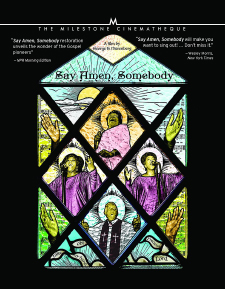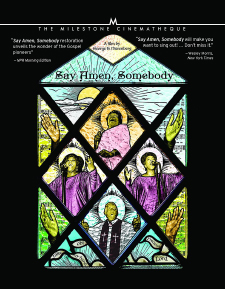Say Amen, Somebody (Blu-ray Review)

Director
George NierenbergRelease Date(s)
1982 (October 26, 2021)Studio(s)
MGM/UA (Milestone Video/Kino Lorber)- Film/Program Grade: A
- Video Grade: A-
- Audio Grade: A-
- Extras Grade: B+
Review
Say Amen, Somebody isn’t just a documentary about gospel music; it’s the documentary about gospel music, a glorious celebration of life, faith, historical legacy, and the sheer unadulterated joy of making music to serve both God and man. All of that is even more remarkable given the fact that it was directed by a then 28-year-old Jewish filmmaker named George T. Nierenberg, who had no experience whatsoever with the genre. His previous film No Maps on My Taps had been about tap dancers in New York, and while he was looking for new subject matter to explore, he asked the legendary guitarist Ry Cooder for suggestions. According to Nierenberg, Cooder’s exact response was, “You oughta look into gospel music; those cats are really neat.” Cooder has always been a notable music historian in his own right, so he knew exactly where to steer Nierenberg, and the results speak for themselves.
Say Amen, Somebody delves into the gospel scene in Chicago, St. Louis, and elsewhere, focusing on elder figures in the field such as Thomas A. Dorsey and Mother Willie Mae Ford Smith, as well as the likes of Zella Jackson Price, the O’Neal twins, and the Barrett sisters. They’re shown performing at home, in churches, at the National Convention of Gospel Choirs and Choruses in Houston, and finally at a touching tribute to Mother Willie Mae Ford Smith in St. Louis. The film also spends time getting to know them personally, looking at their lives and their own feelings about gospel music—there are some interesting conversations regarding the ways in which the genre was moving from its roots in evangelism into a more commercialized and marketable product. Making a living while trying to stay true to your musical principles is a truly universal experience, and it’s fascinating to hear both the older and the younger figures in the gospel field discussing their own feelings about the subject. There are also some fairly pointed examinations of the way that female gospel singers like Mother Willie Mae Ford Smith disrupted the patriarchal nature of traditional ministry.
All of these cats were really neat indeed, and Say Amen, Somebody ended up being not just the definitive document of gospel music, but one of the greatest music documentaries of all time—a worthy member of a distinguished group including films such as The Last Waltz and Stop Making Sense. Nierenberg wisely chose to eschew any narration or even explanatory titles, allowing his subjects to speak for themselves. On the other hand, he still shaped the material behind the scenes, setting up and staging things to capture what he wanted. As he told American Cinematographer, “My directional approach is to create situations over which I have sufficient control. I create environments in which the characters I’ve pre-selected will interact in ways I’ve already observed. While my subject matter may appear to be a documentary, what I am interested in is the narrative structure I can impose.”
That approach would have upset the filmmakers in the Direct Cinema movement of the Fifties and Sixties, as they believed that the camera should observe as unobtrusively as possible, and not interfere with what’s happening. Nierenberg’s methodology even went a bit beyond what the more confrontational Cinema Verite filmmakers of the Sixties and Seventies would have found acceptable. Yet capturing truth isn’t always a simple matter of observing reality, and even the choice of camera angles creates subjective perceptions—with cinema, there is no such thing as objectivity. Nierenberg may have unabashedly guided the material to suit his needs, but the truths that he captured were real and universal. As a result, Say Amen, Somebody provides a glimpse into the world of gospel music which has never been surpassed, and it likely never will be.
Cinematographers Edward Lachman and Don Lenzer shot Say Amen, Somebody on Super 16 mm film using Aaton 7LTR cameras with Cooke 9-50mm zoom lenses. They deliberately overexposed the film by a third of a stop to facilitate the eventual 35 mm blowup for theatrical release. All post-production work was completed on 16 mm film, and 16 mm answer prints were created in order to serve as color timing guides for the blowup process. This 2019 restoration was performed by Metropolis Post, under the supervision of Nierenberg, and produced by the Smithsonian National Museum of African American History and Culture, the Academy Film Archive, and Milestone Films. There’s no information regarding the sources that they used, but it appears that they returned to the original 16 mm film elements rather than using anything from the 35 mm blowup. The resulting image, framed at 1.85:1, looks beautifully filmic. There’s a moderately heavy sheen of grain, but it’s still finer than it would have appeared on the blowups. For the most part, the encoding manages the grain well, though there are occasional shots where it’s mixed with noise. There’s very little damage visible. The color balance looks natural, and while it’s generally restrained, the color scheme springs to life during the performance footage, with vivid colors on the various robes that are being worn by the singers. Contrast and black levels are solid as well, with plenty of detail in the darker parts of the screen.
Audio is offered in English 5.1 and 2.0 DTS-HD Master Audio, with optional English subtitles. The sound for Say Amen, Somebody was captured via a 24-track system in order to record each performer individually, and for this restoration, everything was remixed into 5.1. Yet when comparing this new mix to the original matrixed Dolby Stereo version, the latter still has a slight edge. The 5.1 mix is more precise, but sounds a bit thinner. Even when accounting for level differences, the 2.0 track sounds fuller and more robust, with a bit more heft to the low end. The differences are small and may come down to personal preference, but you really can’t go wrong with either track. The music speaks for itself.
The following extras are included, all in HD:
- Audio Commentary by George T. Nierenberg
- Outtakes of the Barrett Sisters in Rehearsal (50:49)
- New Interview with Zella Jackson Price (16:21)
- George T. Nierenberg Introducing Say Amen, Somebody at the Berlin Film Festival (19:10)
- Audio Outtake: Mother Willie Mae Ford Smith Rehearsal (3:27)
- Audio Outtake: Mother Willie Mae Ford Smith Interview (4:12)
In his commentary track, Nierenberg identifies many of the people and situations that were otherwise presented without explanation in the film. He gives plenty of insights into his process, noting that he wanted to have a personal experience with everyone before he filmed any scenes, and it informed the way that he guided the production. The cameras (surprisingly, there were only three of them) didn’t merely film events as they unfolded; rather, Nierenberg created the events specifically to be filmed. He describes the way that he set up those various moments, and also points out which ones were spontaneous. The track is a little sparse, with Nierenberg chiming in somewhat erratically, but it’s a useful way to understand the choices that he made.
The Outtakes are divided into four reels (encoded as individual chapters), and presented open matte at 1.37:1. They show the Barrett sisters working with pianist Charles Pike, practicing songs, and even developing new material. The footage is sometimes raw, but it’s an invaluable look at the hard work that these artists do behind the scenes in order to make it look so effortless on stage. The New Interview with Zella Jackson Price was conducted by Nierenberg himself. She discusses a variety of subjects such as Mother Willie Mae Ford Smith, the Barrett sisters, and being a woman in the gospel field. She also talks about African American spirituality, her famous song I’m His Child, working with Nierenberg, and the restoration of the film. George T. Nierenberg Introducing Say Amen, Somebody at the Berlin Film Festival is a Q&A between Nierenberg and an unnamed interviewer, conducted in 2019. Nierenberg tells the story about Ry Cooder; describes how he chose the various artists featured in the film; explains the way that he set up scenes to demonstrate things that he had already observed with them; and how he wanted the music to drive the narrative of the film. He also takes some questions from the audience. The two Audio Outtakes feature rehearsal footage of Mother Willie Mae Ford Smith, and a brief interview with her that wasn’t included in the final film.
Say Amen, Somebody isn’t just a film; it’s an experience. Thanks to this lovely restoration, it can now be experienced at home with impeccably high quality. Amen, indeed.
- Stephen Bjork
(You can follow Stephen on social media at these links: Twitter and Facebook.)

